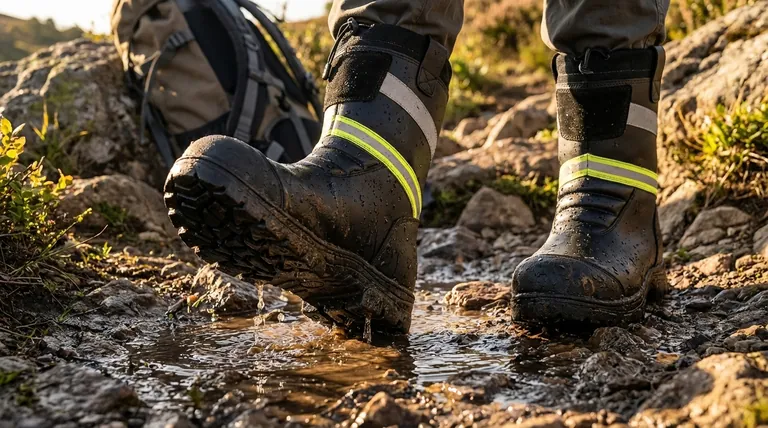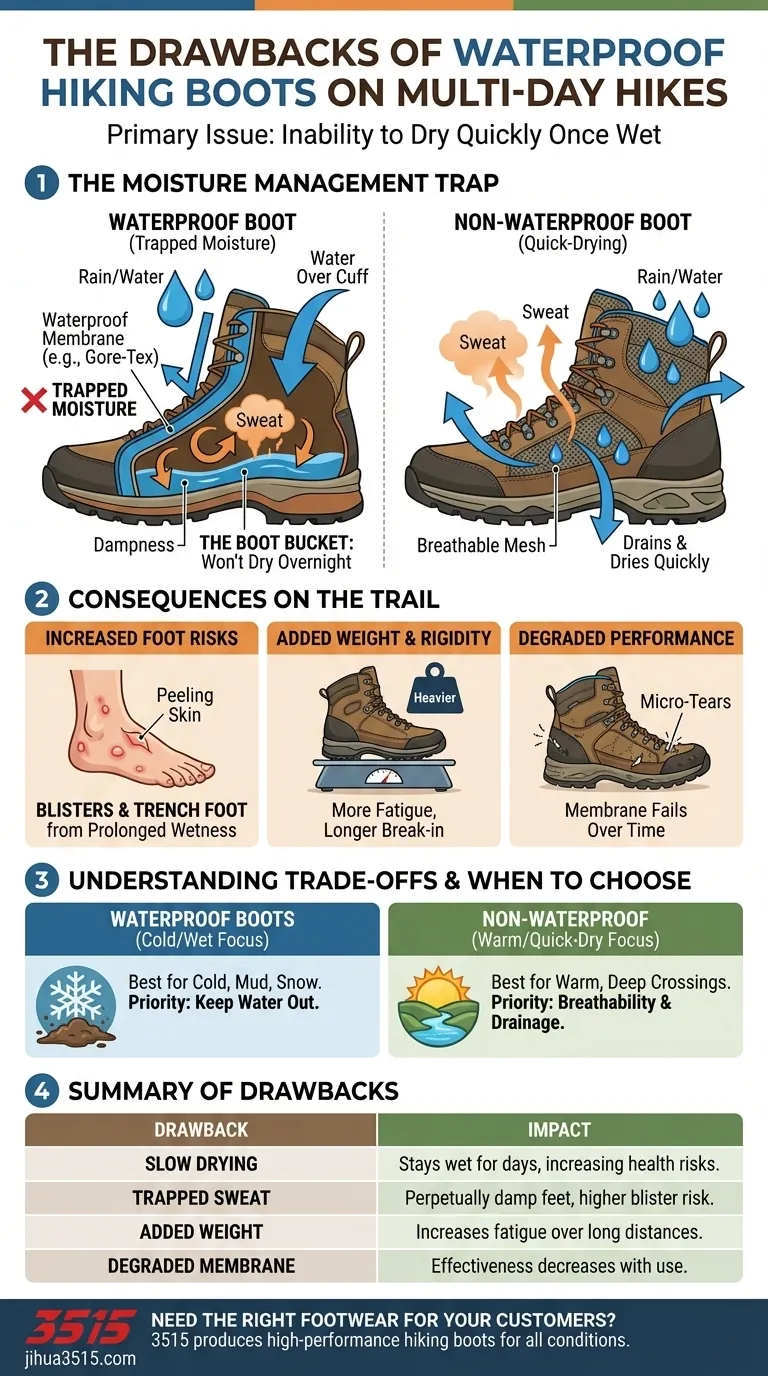Ultimately, the primary drawback of waterproof hiking boots on multi-day hikes is their inability to dry quickly once wet. While designed to keep external water out, they inadvertently trap internal moisture from sweat or from water that overtops the cuff, creating a perpetually damp environment for your feet that can lead to significant problems over several days.
The core issue isn't whether your feet will get wet, but how you manage that moisture. Waterproof boots excel at preventing water from getting in, but they fail at letting it out, creating a greater risk for foot-related issues on longer treks compared to quick-drying, non-waterproof alternatives.

The Moisture Management Problem
The term "waterproof" can be misleading. It promises dry feet, but the reality on a long trail is far more complex. The technology that achieves this waterproofing is also the source of its primary drawbacks.
How Waterproof Membranes Work
Most waterproof boots use a membrane, like Gore-Tex, which contains microscopic pores. These pores are small enough to block liquid water droplets from entering but large enough to allow water vapor (sweat) to escape. In theory, this creates a one-way street for moisture.
The Reality of Trapped Sweat
In practice, this system has limits. On a warm day or during strenuous hiking, your feet produce sweat faster than the membrane can vent it. This moisture becomes trapped, slowly saturating your socks and the inside of your boot.
The Point of No Return: The "Boot Bucket"
The most significant failure occurs when water goes over the top of the boot, such as during a deep stream crossing. Once fully saturated, the waterproof membrane works against you, holding the water inside like a bucket. The boot will not dry overnight and may stay wet for the remainder of your trip.
The Consequences on a Multi-Day Hike
A damp boot for a few hours is an inconvenience. A damp boot for several days is a liability that can compromise your entire hike.
Increased Risk to Foot Health
Prolonged exposure to moisture is the leading cause of trail-related foot issues. It softens the skin, making it dramatically more susceptible to painful blisters. In colder, persistently wet conditions, it can lead to more serious issues like trench foot.
The Burden of Weight and Flexibility
Waterproof boots are inherently heavier and more rigid than their non-waterproof counterparts due to the membrane and more durable materials. This added weight increases fatigue over many miles and days, and their stiffness can require a longer break-in period.
Degraded Performance Over Time
The waterproof membrane is not permanent. The constant flexing of the boot, especially around the forefoot, eventually creates micro-tears in the membrane, degrading its effectiveness over the life of the boot.
Understanding the Trade-offs
Choosing footwear is about aligning your gear with the most probable conditions of your hike. Neither option is universally superior.
When Waterproof Boots Excel
Waterproof boots are the ideal choice for hikes in consistently cold, wet, and muddy conditions. In these environments, keeping external moisture out is the absolute priority, and the risk of sweating profusely is lower. Their stability and durability are also critical on rough, uneven terrain.
The Advantage of Non-Waterproof Footwear
Non-waterproof trail runners or hiking shoes are built with breathability and drainage in mind. When they get wet, they are designed to drain water and dry quickly, often within hours of walking in the sun. This makes them superior for hikes in warm weather or trips that involve numerous, unavoidable deep-water crossings.
How to Apply This to Your Hike
Your choice should be dictated by the environment you anticipate, not by a desire for universally "dry" feet.
- If your primary focus is hiking in cool to cold weather with mud, snow, or shallow streams: A waterproof boot is likely your best defense against the elements.
- If your primary focus is hiking in warm or mixed weather with deep river crossings: A non-waterproof, quick-drying shoe will manage inevitable wetness far more effectively.
- If your primary focus is maximizing comfort on dry, well-maintained trails: A lightweight, highly breathable non-waterproof shoe will keep your feet cooler and reduce fatigue.
Ultimately, the best hiking footwear is the one that best manages the specific type of moisture you are most likely to encounter.
Summary Table:
| Drawback | Impact on Multi-Day Hikes |
|---|---|
| Slow Drying | Boots stay wet for days if submerged, increasing discomfort and health risks. |
| Trapped Sweat | Creates a perpetually damp environment, softening skin and raising blister risk. |
| Added Weight & Rigidity | Increases fatigue over long distances and requires a longer break-in period. |
| Degraded Waterproofing | Membrane effectiveness decreases over time with constant flexing and wear. |
Need the Right Footwear for Your Next Expedition?
As a large-scale manufacturer, 3515 produces a comprehensive range of high-performance hiking boots and shoes for distributors, brand owners, and bulk clients. Whether your customers need durable waterproof boots for cold, wet trails or quick-drying, breathable footwear for warm-weather adventures, our production capabilities encompass all types of outdoor footwear.
Let us help you equip your customers for success on the trail.
Contact our team today to discuss your specific needs and discover how 3515 can be your reliable manufacturing partner.
Visual Guide

Related Products
- High Performance Fire-Retardant Waterproof Safety Boots
- Premium Wholesale Waterproof Safety Boots High Performance Protection for Industrial Markets
- Premium Flame-Retardant Waterproof Safety Boots and Shoes
- Factory Direct Wholesale Rain Boots Durable Waterproof & Fully Customizable
- Factory-Direct Wholesale Canvas Boots with High-Traction Rubber Soles
People Also Ask
- Which industries commonly use steel toe boots? Essential Foot Protection for High-Risk Jobs
- Why choose steel toe boots over composite? For Maximum Impact Protection & Durability
- What are the main types of safety-toe boots? Choose the Right Protection for Your Job
- What standards are used to test and rate safety-toe footwear? Ensure Your Boots Are Truly Protective
- What are the different types of materials used in the toe portion of safety toe work boots? A Guide to Steel, Alloy & Composite



















